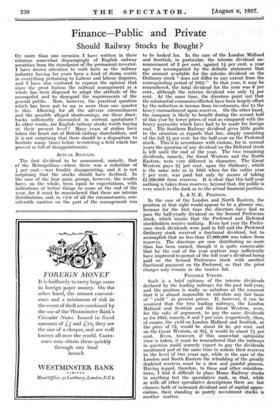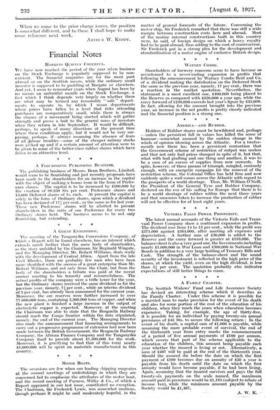Finance—Public and Private
Should Railway Stocks be Bought ?
ON more than one occasion I have written in these columns somewhat disparagingly of English railway securities from the standpoint of the permanent investor. I have drawn attention to such facts as the railway industry having for years been a kind of storm centre in everything pertaining to Labour and labour disputes, and I have also ventured to express the opinion that since the great fusions the railroad management as a whole has been disposed to adopt the attitude of the monopolist and to disregard the requirements of the general public. Now, however, the practical question which has been put to me in more than one quarter is this. Allowing for all the adverse circumstances and the possible alleged shortcomings, are these draw- backs sufficiently discounted in current quotations ? In other words, arc English railway stocks worth buying at their present level ? Many years of strikes have taken the heart out of British railway shareholders, and it is not surprising that there should be a disposition to hesitate many times before re-entering a field which has proved so full of disappointments.
ACTUAL RESULTS.
The first dividend to be announced, namely, that of the Metropolitan—where there was a reduction of f per cent.—was frankly disappointing, and it is not surprising that the stocks should have declined. In the case of the four main groups, however, the results have, on the whole, been equal to expectations, with indications of better things to come at the end of the year, for it must be remembered that these are interim distributions, and, in view of all the circumstances, con- siderable caution on the part of the management was to be looked for. In the case of the London Midland and Scottish, in particular, the interim dividend an- nouncement of 2 per cent. against 1f per cent. a year ago was accompanied by the definite statement that the amount available for the interim dividend on the Ordinary stock " does not differ to any extent from the corresponding period of 1925." In that year, it may be remembered, the total dividend for the year was 6 per cent., although the interim dividend was only 1f per cent. At the same time, the directors point out that the substantial economies effected have been largely offset by the reduction in income from investments, due to the heavy encroachment upon reserves. On the other hand, the company is likely to benefit during the second half of this year by lower prices of coal as compared with the heavy payments which have had to be made for foreign coal. The Southern Railway dividend gives little guide to the situation as regards that line, simply consisting of the full 2f per cent. for the half-year on the Preferred stock. This is in accordance with custom, for in normal years the question of any dividend on the Deferred stock is left until the end of the year. The two remaining dividends, namely, the. Great Western and the North Eastern, were very different in character. The Great Western pays 2t per cent. upon the Ordinary, which is the same rate as in 1925 when- for the entire year 7 per cent. was paid but only by means of taking £1,200,000 from reserves. It is clear that this half-year nothing is taken from reserves; beyond that, the public is very much in the dark as to the actual financial position.
L. & N. E. POSITION.
In the case of the London and North Eastern, the - position at first sight would appear to be a gloomy one, because for the first time the directors have had to pass the half-yearly dividend on the Second Preference stock, which means that the Preferred and Deferred stockholders receive nothing. Even last year the Prefer- ence stock dividends were paid in full and the Preferred Ordinary stock received a fractional dividend, but to accomplish that no less than £7,000,000 was taken from reserves. The directors are now distributing no more than has been earned, though it is quite conceivable that by the end of the year matters may sufficiently have improved to permit of the full year's dividend being paid on the Second Preference stock with another fractional payment on the Preferred, so that the prior charges may remain in the trustee list.
POSSIBLE YIELDS.
Such is a brief epitome of the interim dividends declared by the leading railways for the past half-year, and the position is really so nebulous at the moment that it is almost impossible to calculate any fair basis of " yield " at present prices. If, however, it can be assumed that the two leading railways, the London Midland and Scottish and the Great Western, were, for the sake of- argument, to pay the same dividends as for 1925, namely, 6 and 7 per cent. respectively, then, of course, the yield on London Midland and Scottish, at the price of 72, would be about £8 6s. per cent. and on the Great Western, at 92k, it would be about 71 per cent. Even, however, if this somewhat optimistic view is taken, it must be remembered that the railways in question could scarcely expect to pay the dividends mentioned and at the same time to restore their reserves to the level of two years ago, while in the case of the London and North Eastern the rebuilding of the greatly depleted reserves must be a slow and painful process. Having regard, therefore, to these and other considera- tions, I find it difficult to place Home Railway stocks in anything but the speculative rank, so that, while- as with all other speculative descriptions there are fair chances both of increased dividend and of capital appre- ciation, their standing as purely investment stocks is another matter. - When we come to the prior charge issues, the position is somewhat different, and to these I shall hope to make some reference next week.
ARTHUR W. KIDDY.







































 Previous page
Previous page